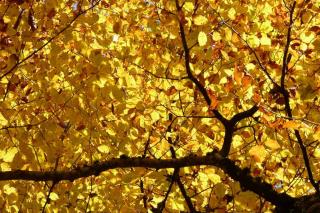

Fall is the season of nature’s grand finale, an explosion of color before a well-deserved rest. Like a show of fireworks, a culmination of powerful fiery bursts of color bursts forth from trees left and right in the scenery and in the garden.
Gold in particular flashes and shines in all its rich tan-to-orange leaves, a compelling yellow landscape that pairs well with the soft, dull light of the season.
Set your own garden up for these bursts of color in autumn, before deciduous trees bare their slender frame.
 Many different types of ornamental maple display brown, orange and red hues in fall – and they all go through bright yellow beforehand. Savor this golden mantle for long weeks with the common maple species that grow naturally in our areas, such as Norway maple (Acer platanoides) which has leaves nearly identical to those of the plane tree. Its leaves typically take on a bright yellow color in fall, except for purple-leaved cultivars.
Many different types of ornamental maple display brown, orange and red hues in fall – and they all go through bright yellow beforehand. Savor this golden mantle for long weeks with the common maple species that grow naturally in our areas, such as Norway maple (Acer platanoides) which has leaves nearly identical to those of the plane tree. Its leaves typically take on a bright yellow color in fall, except for purple-leaved cultivars.
The sycamore maple (Acer pseudoplatanus) structures its leaves in a nice way, with gold yellow leaf lobes carried on a stark red petiole.
The smaller-sized 12 to 20 feet (4 to 9 meters) field maple (Acer campestre) is the last to shift its palette to gold in fall, an excellent addition to a freestyle hedge. Sometimes, though, leaves turn red instead of gold yellow.


Leaves are unlike any other in the plant world. Rich, gold yellow color covers the tree in autumn, and a simple gust of wind sends them fluttering around. After a decade or so, orange tulip-shaped flowers appear in June. This tree appreciates deep, cool and fertile ground. Note that it should drain very well in winter. Better too, if the soil is slightly acidic. It likes light and part shade, but too much direct sun might burn leaves in dry weather.
Remember to plant it away from walkways and electric wires because the wood is brittle and breaks off as it ages. This tree doesn’t react well to pruning, so only plant it in a spot that can let it grow unfettered.

Sole survivor of a family that disappeared from Earth 100 million years ago, this tree is one of the oldest known living fossils. It doesn’t exist anymore in the wild, and probably owes its survival to a tradition of planting it in Chinese temples. Its fan-shaped leaves are unique in today’s plant kingdom. They hang like gold coins from branches in fall.
